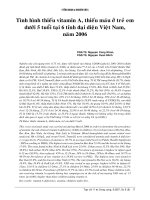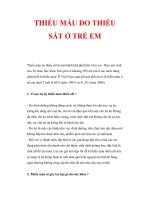Thiếu máu thiếu sắt ở trẻ em
Bạn đang xem bản rút gọn của tài liệu. Xem và tải ngay bản đầy đủ của tài liệu tại đây (1.12 MB, 59 trang )
IRON-DEFCIENCY
ANEMIA
INTRODUCTION
• Iron deficiency: ID, a state in which
there is insufficient iron to maintain
normal physiologic functions.
• Anemia: A hemoglobin concentration
2 SDs below the mean Hb
concentration for a population of the
same gender and age range.
• Iron-deficiency anemia: IDA, top
cause of anemia
Children are at risk of IDA:
• < 24 months of age: rapid growth + frequently inadequate
intake of dietary iron places children at the highest risk of any
age group for ID.
• > 24 months of age, the growth rate of children slows and the
diet becomes more diversified
• > 36 months of age, dietary iron and iron status are usually
adequate.
MODIFICATIONS OF IRON
HOMEOSTASIS IN ID
• Tightly regulated by hepcidin-based homeostatic controls
• Hepcidin:
• a peptide hormone, synthesized primarily in the liver
• increases in response to high circulating and tissue levels of iron
• [hepcidin] have a strong direct correlation with [serum ferritin]
• inhibited by(1)
• erythropoiesis
• iron deficiency
• tissue hypoxia
In iron deficiency,
• The transcription of hepcidin is suppressed, facilitates:
• the absorption of iron
• the release of iron from body stores
IRON REQUIREMENTS
• IRON REQUIREMENTS FOR TODDLERS
• 7 mg/day
• IRON REQUIREMENTS FOR TERM INFANTS
• Term infants 0 – 6 months: 0.27 mg/day
• Term infants 7 – 12 months: 11 mg/day
• IRON REQUIREMENTS FOR PRETERM INFANTS
• estimated to be 2 - 4 mg/kg per day PO
• 80% of the iron present in a newborn term infant is
accreted during the third trimester of pregnancy.
• The deficit of total body iron in preterm infants
• increases with decreasing gestational age
• worsened by the rapid postnatal growth
• Tranfusions:
• sick preterm infants who receive multiple transfusions are
at risk of iron overload
• Recombinant human erythropoietin:
• further deplete iron stores if additional supplemental iron
is not provided
ETIOLOGY
• Most iron in neonates is in circulating hemoglobin
• As the relatively high hemoglobin concentration of the
newborn infant falls during the first 2-3 mo of life,
considerable iron is recycled
• These iron stores are usually sufcient for blood
formation in the first 6-9 mo of life in term infants
• In term infants, anemia caused solely by inadequate
dietary iron usually occurs at 9-24 mo of age and is
relatively uncommon thereafer.
• (1) inadequate intake
• (2) blood loss
• (3) malabsorption of iron
• malabsorptive syndromes such as inflammatory bowel
disease
• Chronic blood loss
• Commonly causes ID
• Particularly menstrual and gastrointestinal tract bleeding
• Idiopathic pulmonary hemosiderosis: rare
• Involved infants characteristically develop anemia
• more severe
• occurs earlier
than would be expected simply from an inadequate intake
• Occult gastrointestinal tract bleeding may be caused
by
• A lesion of the gastrointestinal (GI) tract: peptic ulcer,
Meckel diverticulum, polyp, hemangioma, or
inflammatory bowel disease
• Allergy to cow’s milk
• Infections: Necator americanus, Trichuris trichiura,
Plasmodium, H. pylori
CLINICAL MANIFESTATIONS
• Most children with iron defciency are asymptomatic
and are identified by recommended laboratory
screening at 12 mo of age, or sooner if at high risk.
• Pallor is the most important clinical sign of iron
deficiency but is not usually visible until the
hemoglobin falls to 7-8 g/dL.
• Pallor, tachycardia, and systolic murmur are more
prevalent as the microcytic, hypochromic anemia
worsens.
• Epithelial changes such as atrophy of the papillae of
the tongue and spooning of the fingernails: unusual in
children.
• Iron defciency has nonhematologic systemic effects
• affect growth
• cause potentially irreversible mental and psychomotor
developmental abnormalities in children < 2 years old
DETERMINATION OF IRON
STATUS
First,
• Tissue iron stores are depleted
• This depletion is reflected by reduced serum ferritin
(<10 – 15 ng/mL), an iron-storage protein, which
provides an estimate of body iron stores in the
absence of inflammatory disease.









